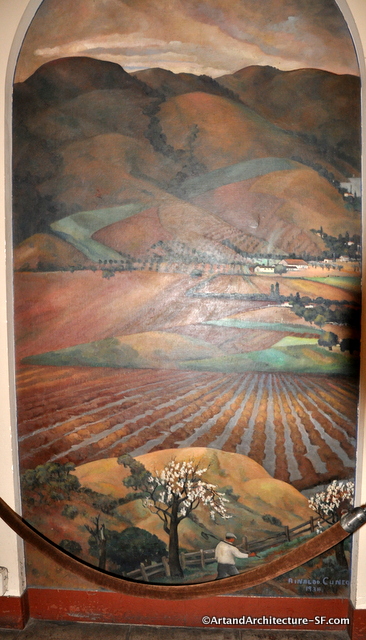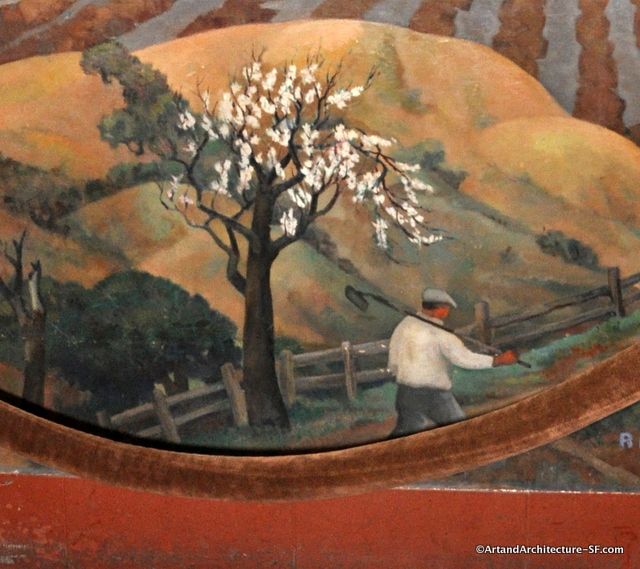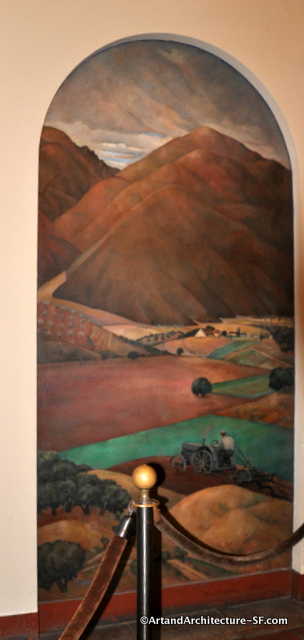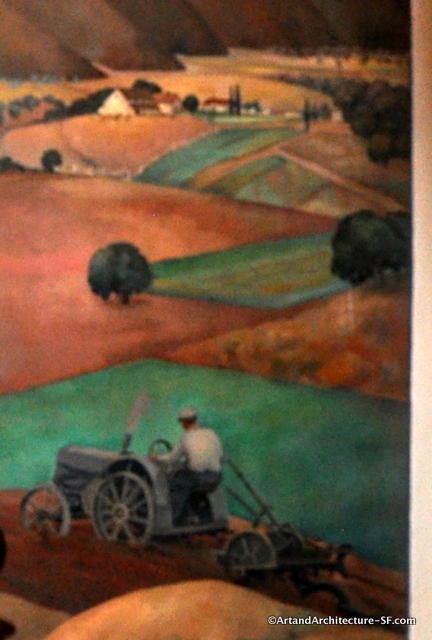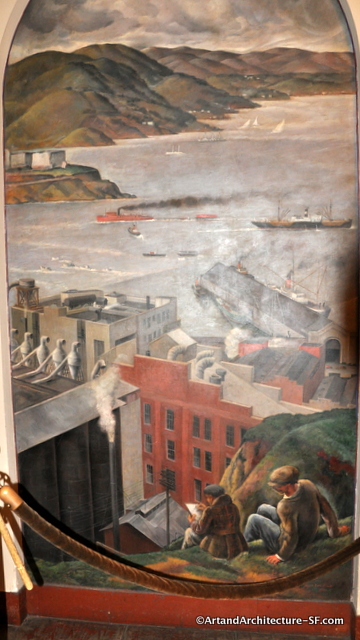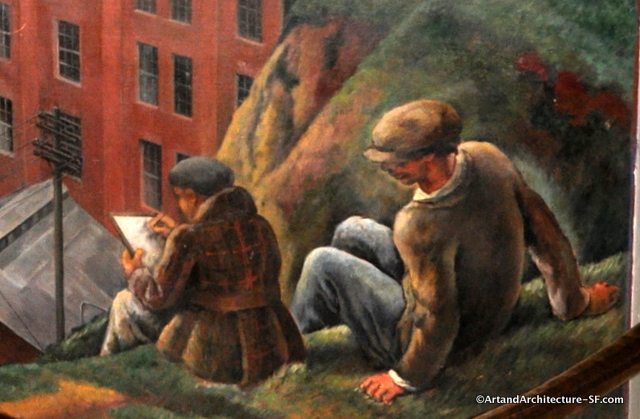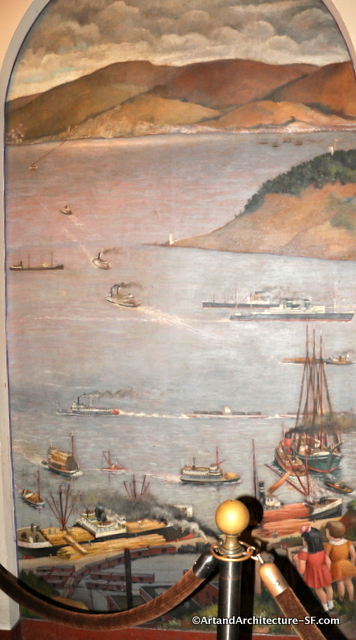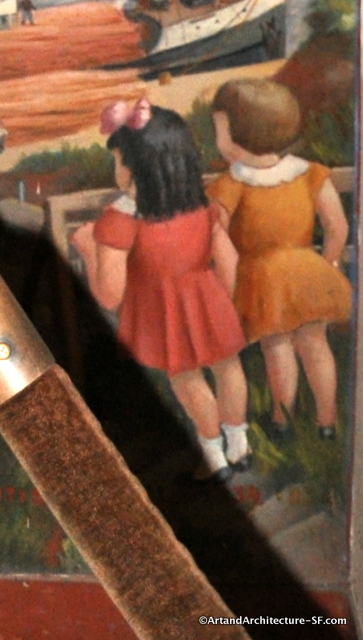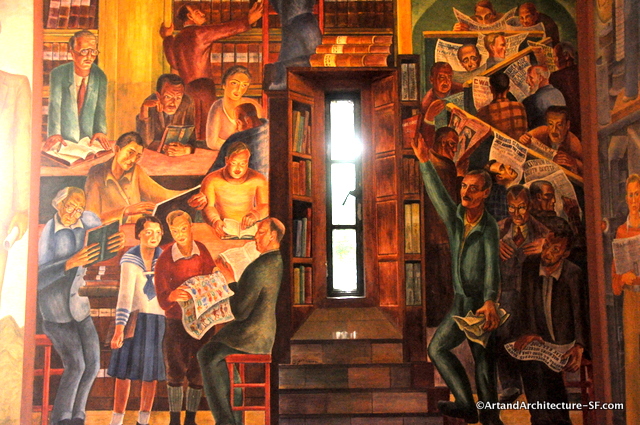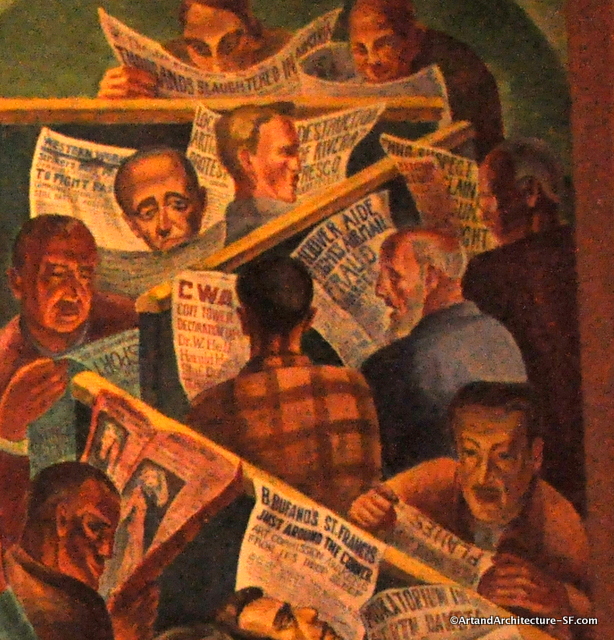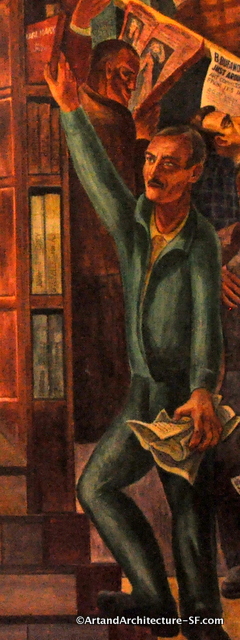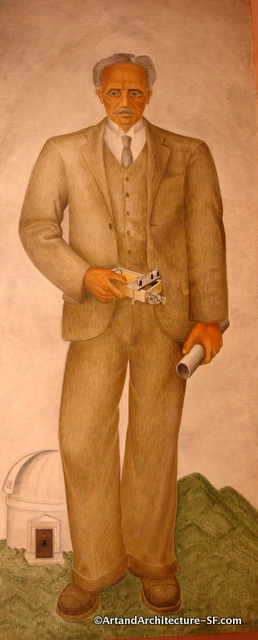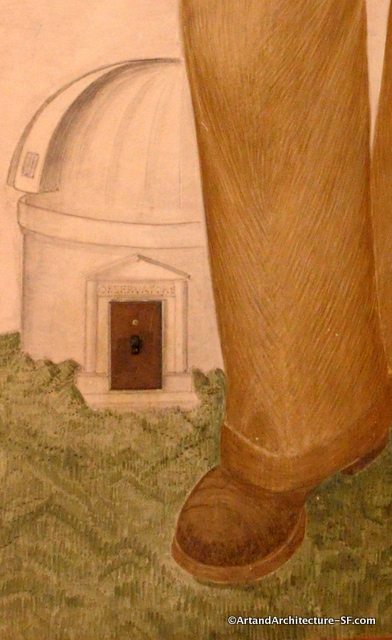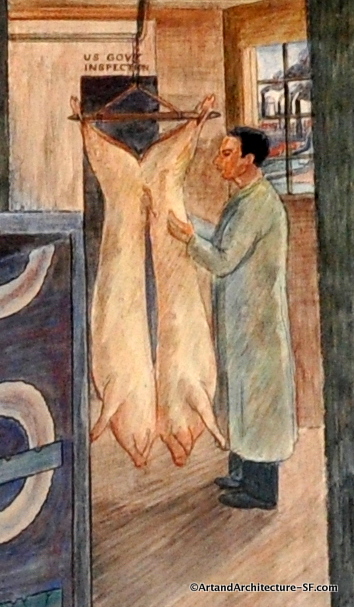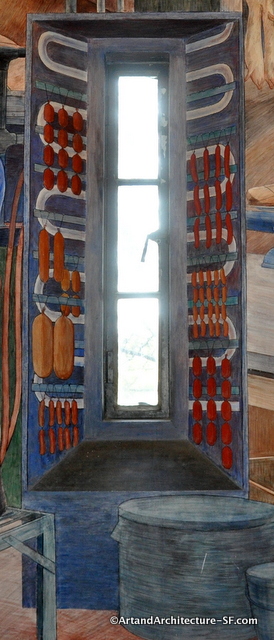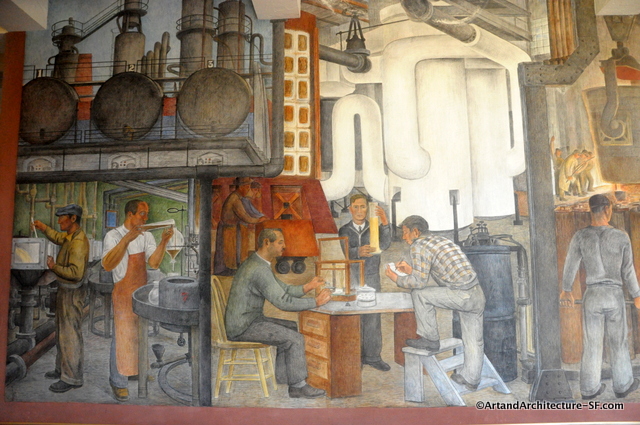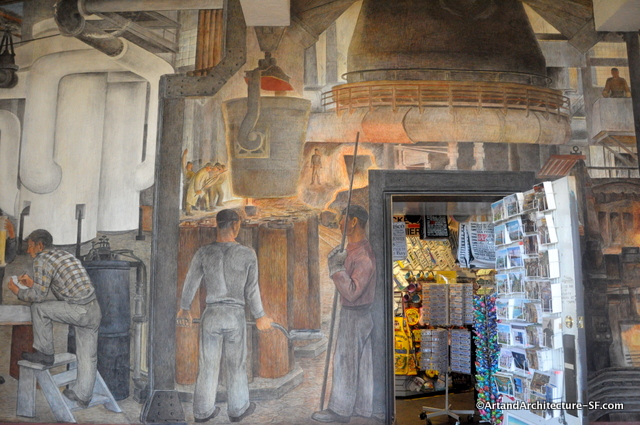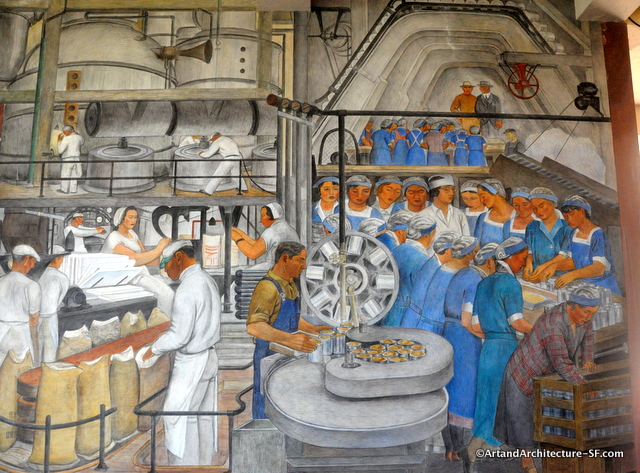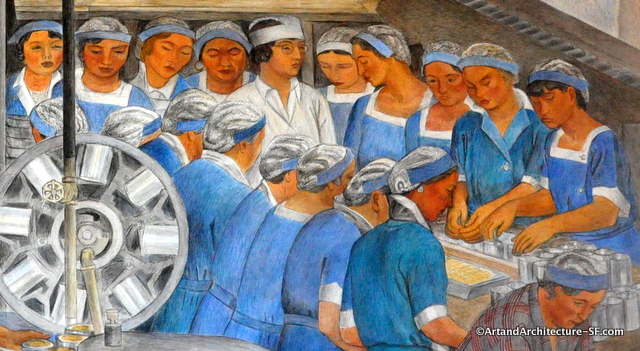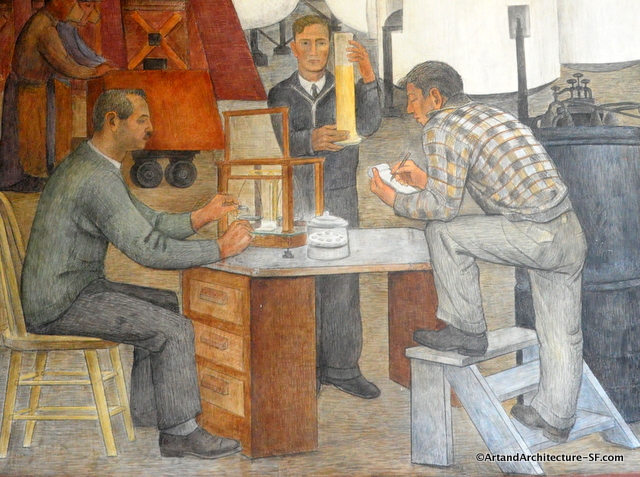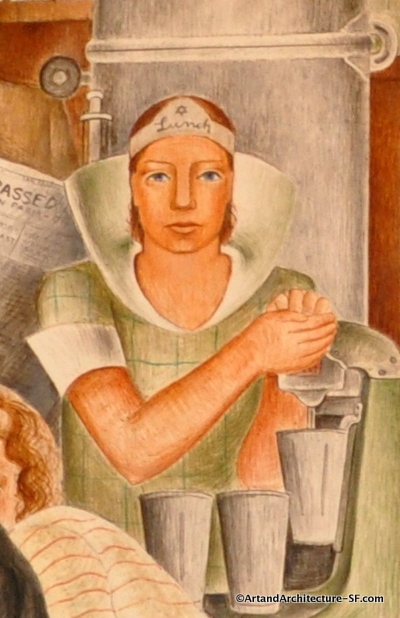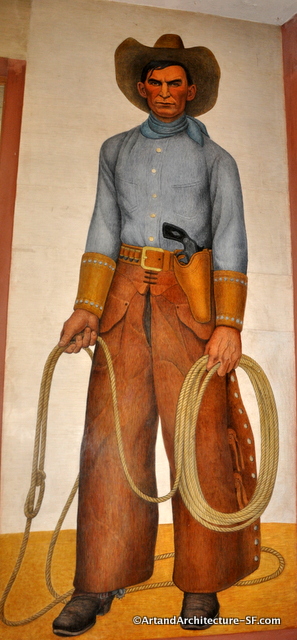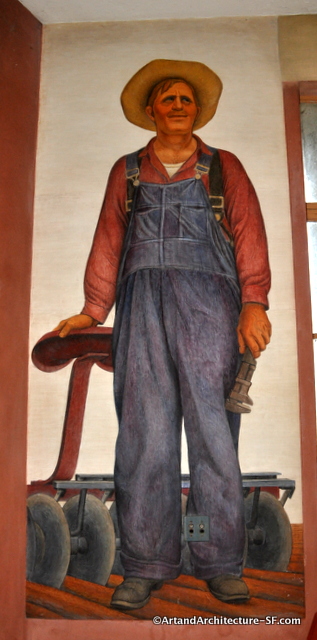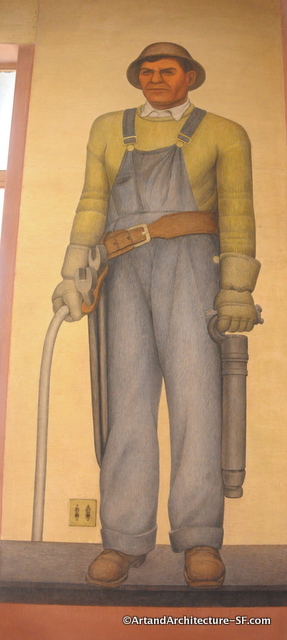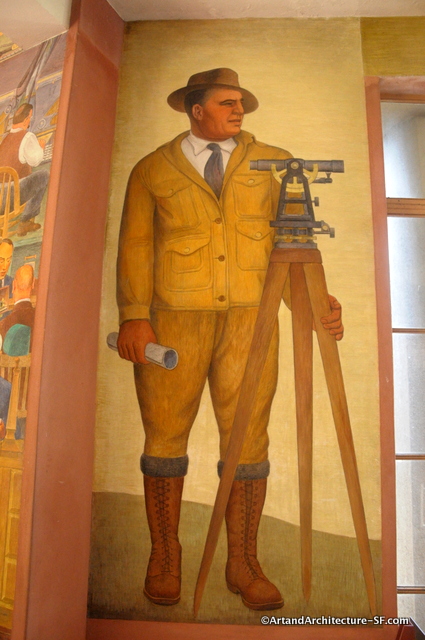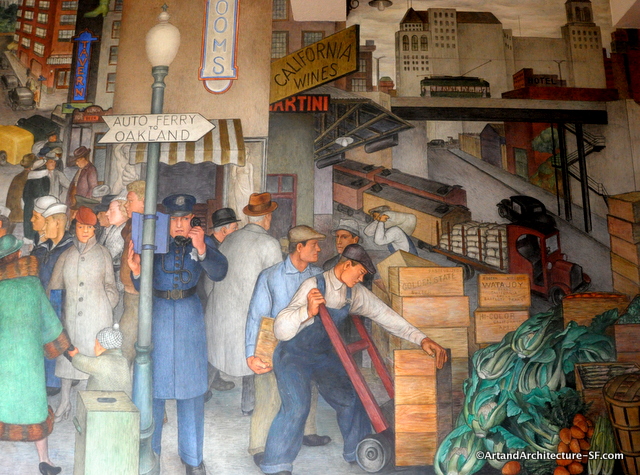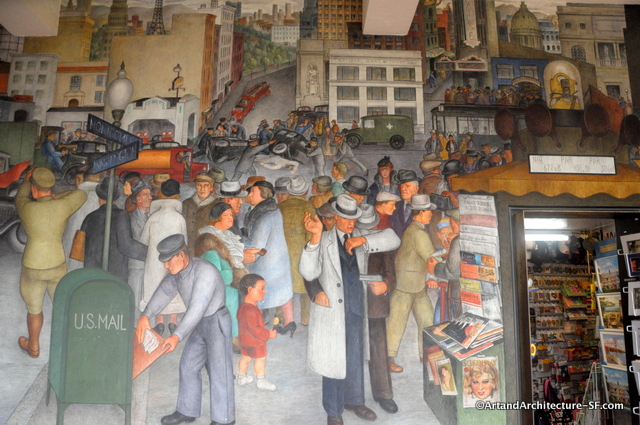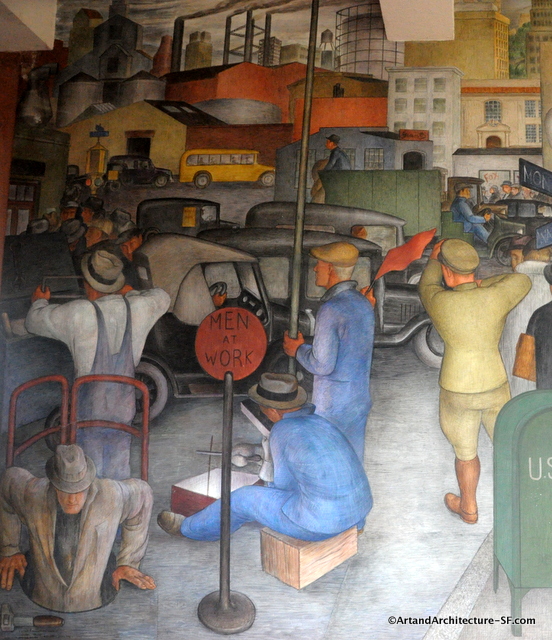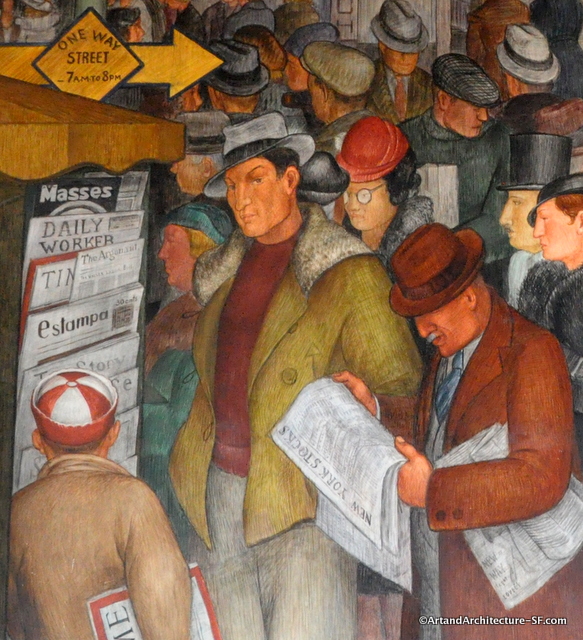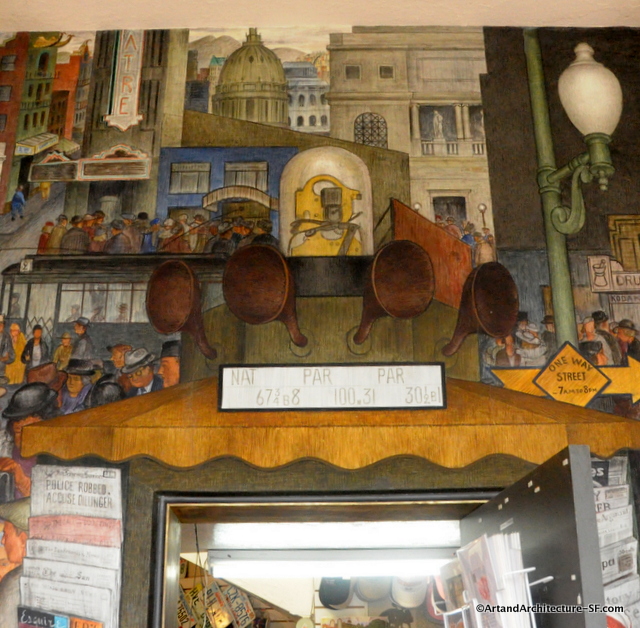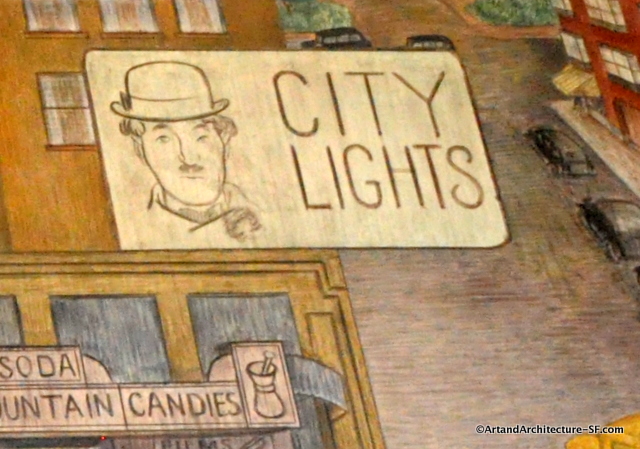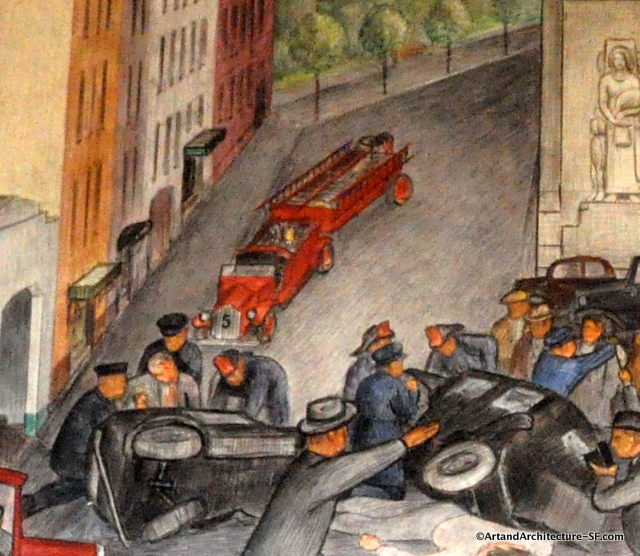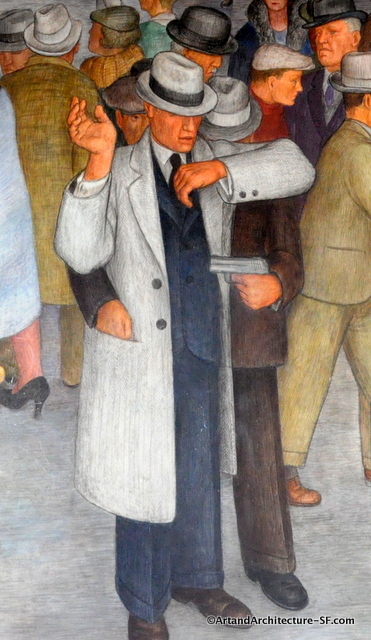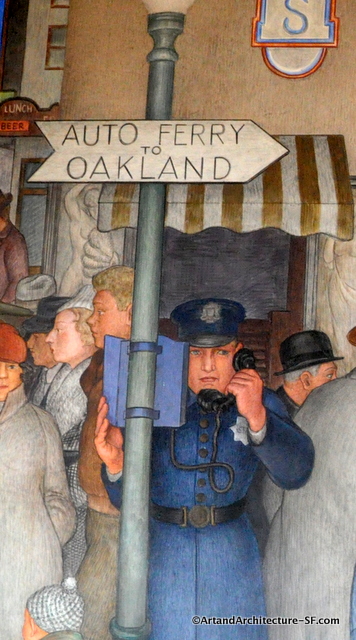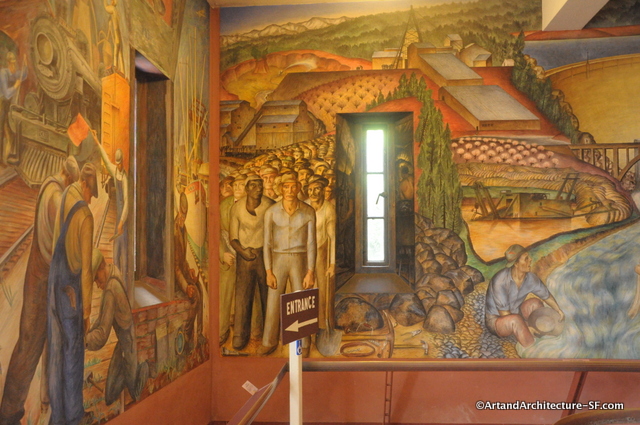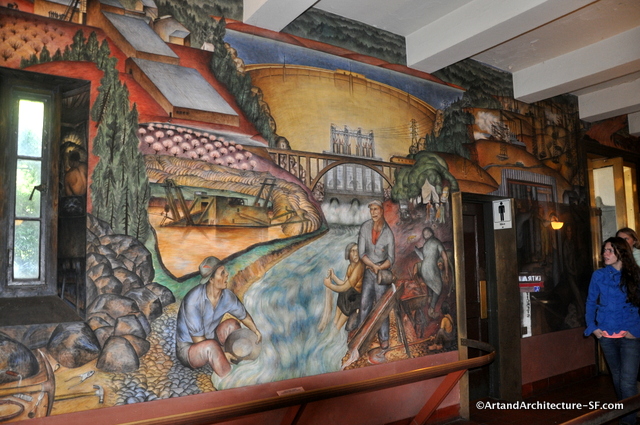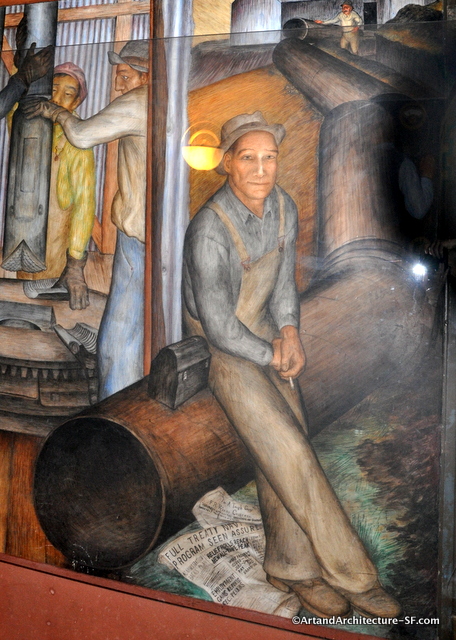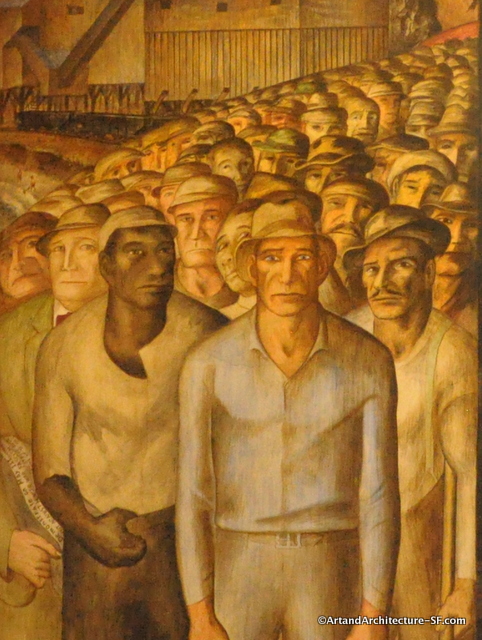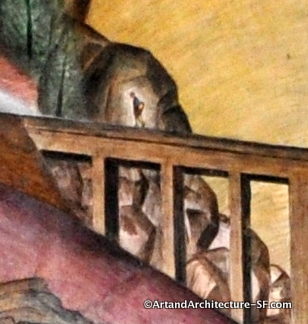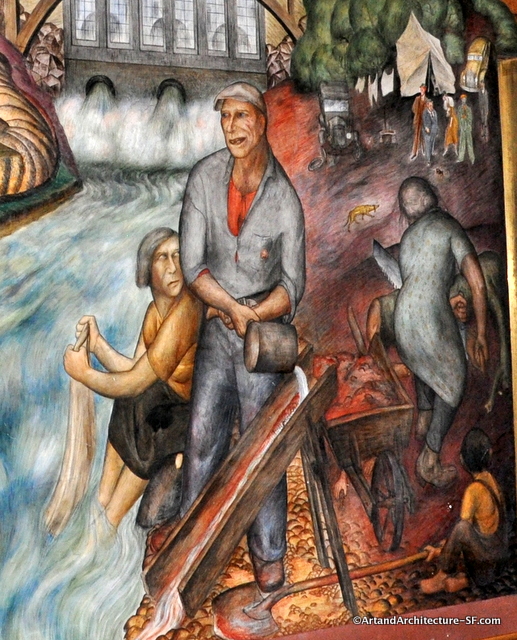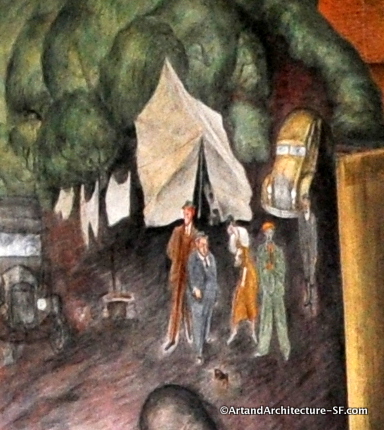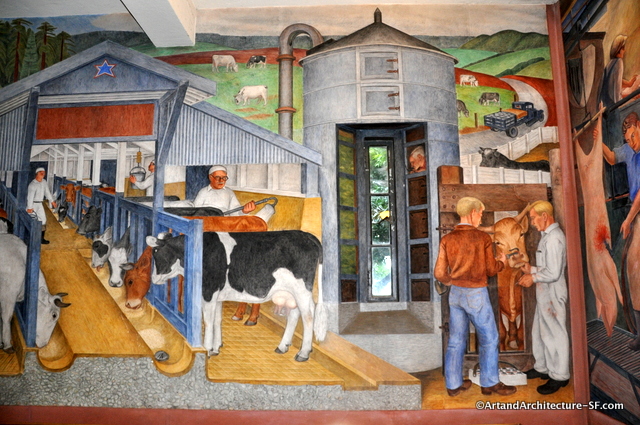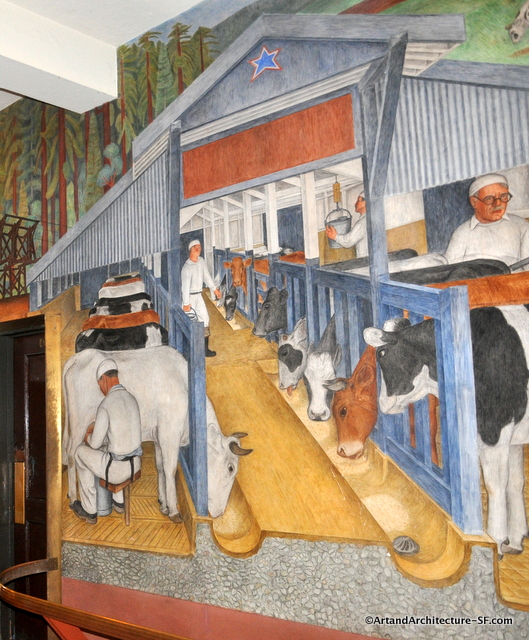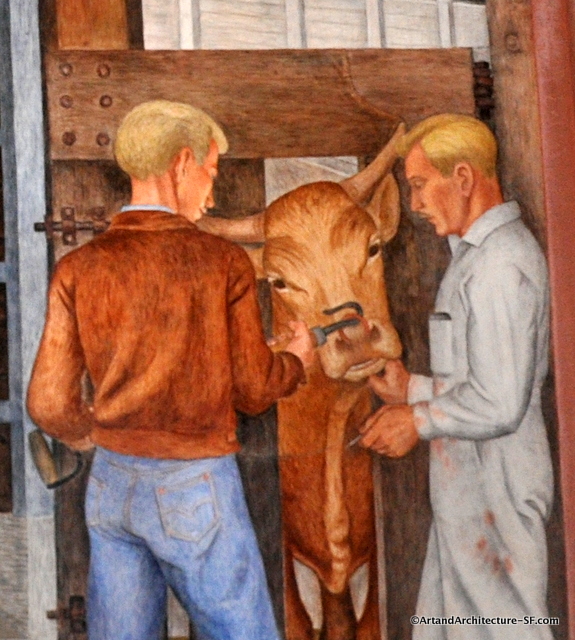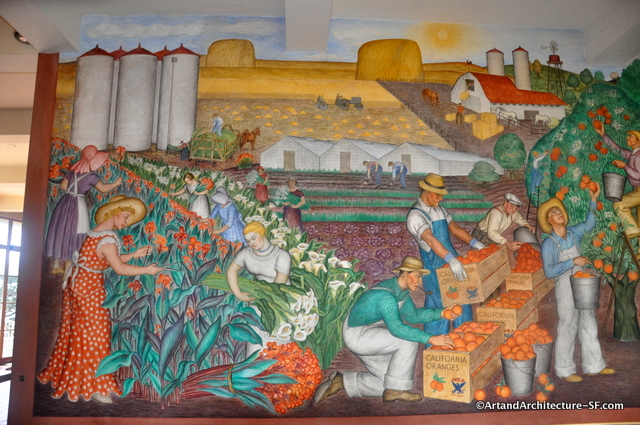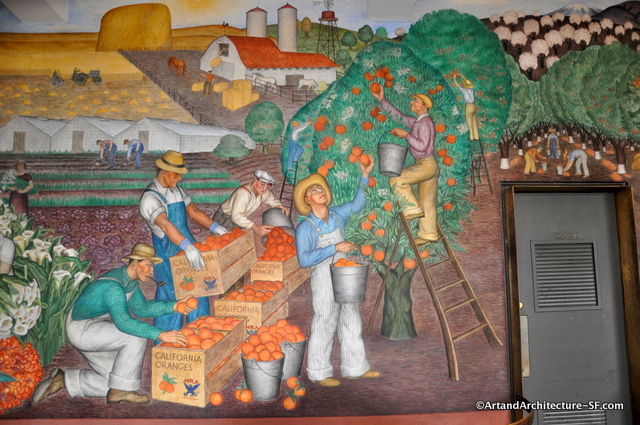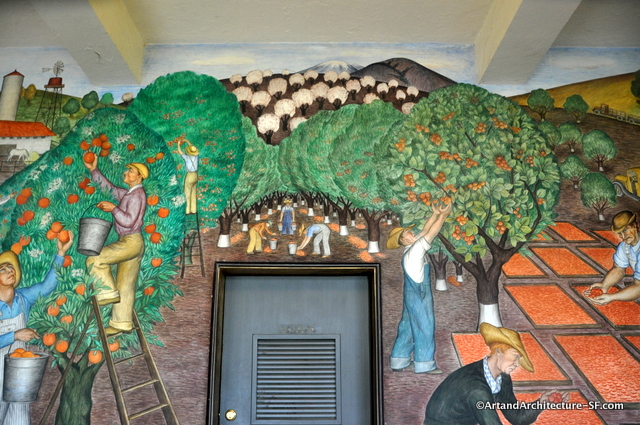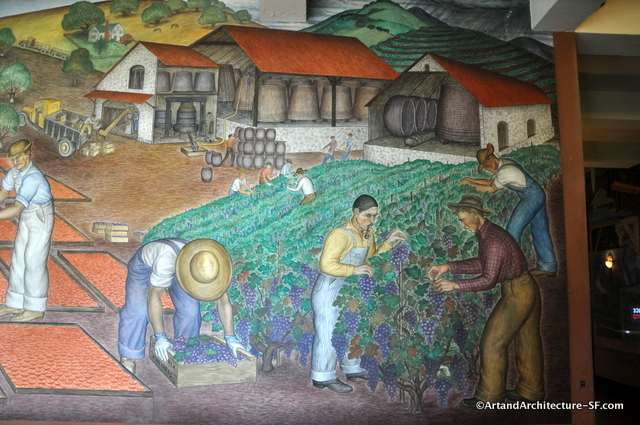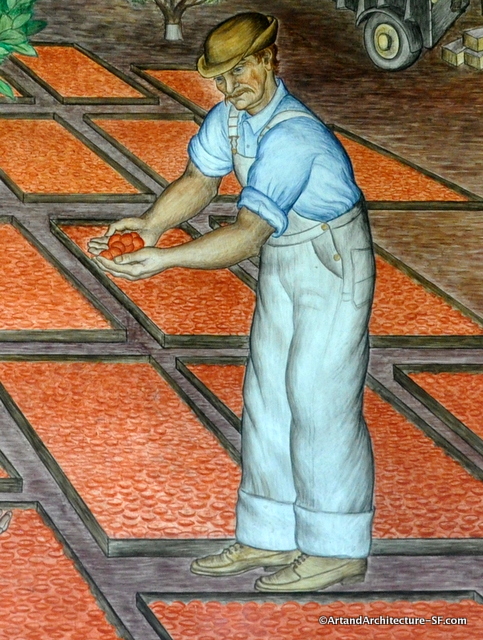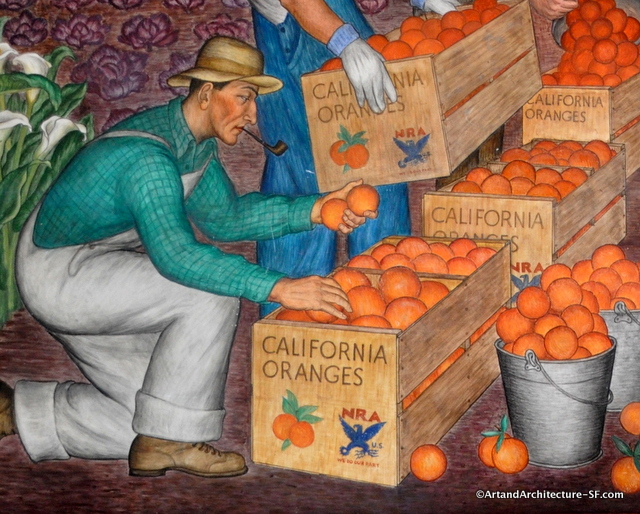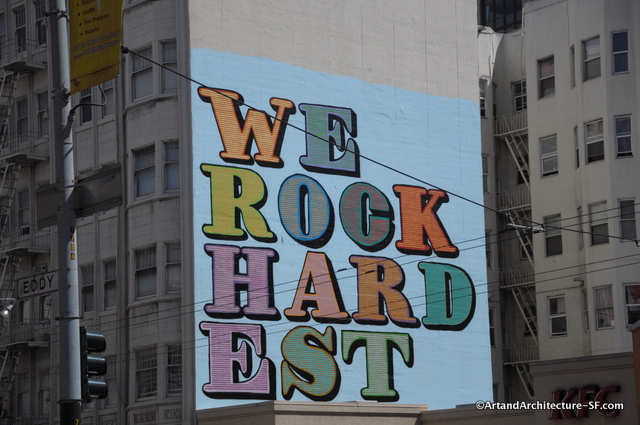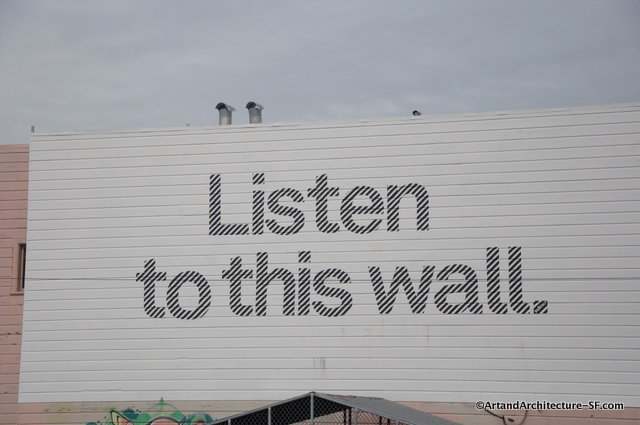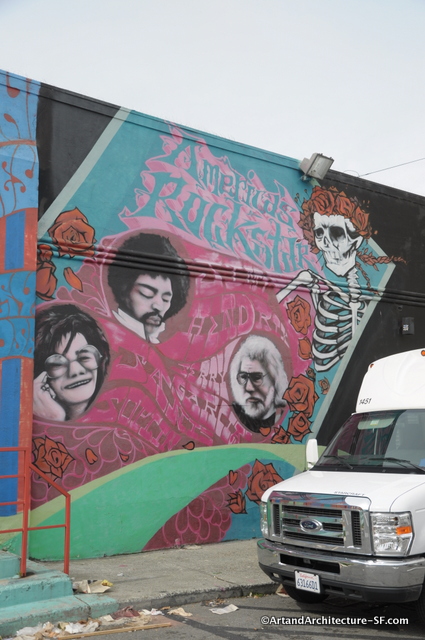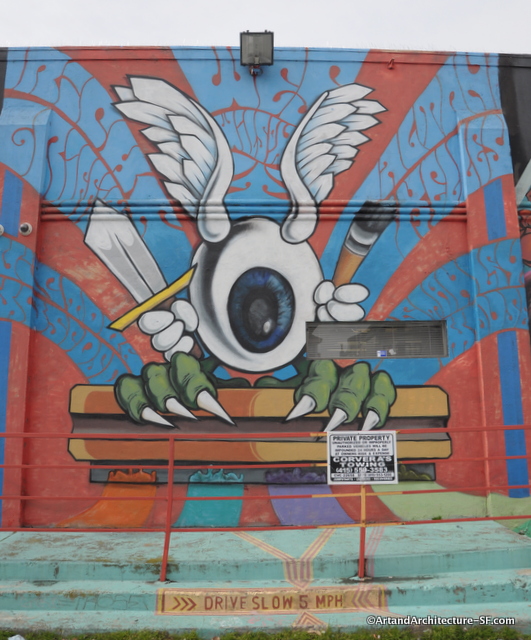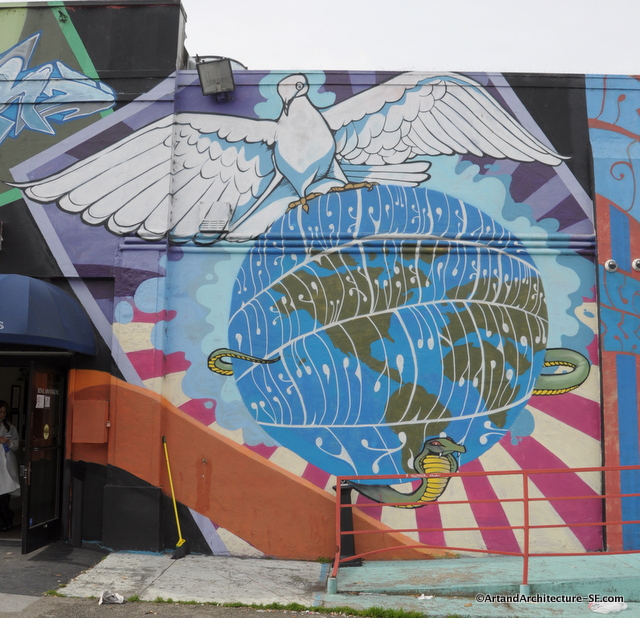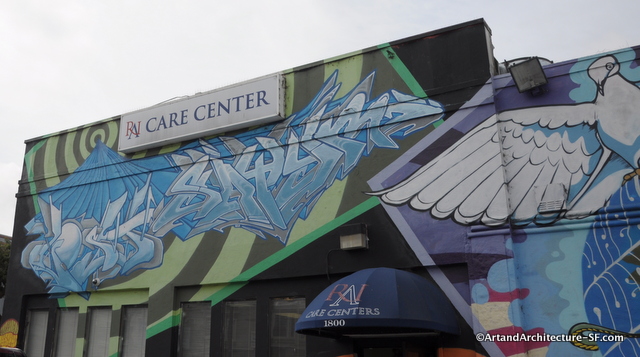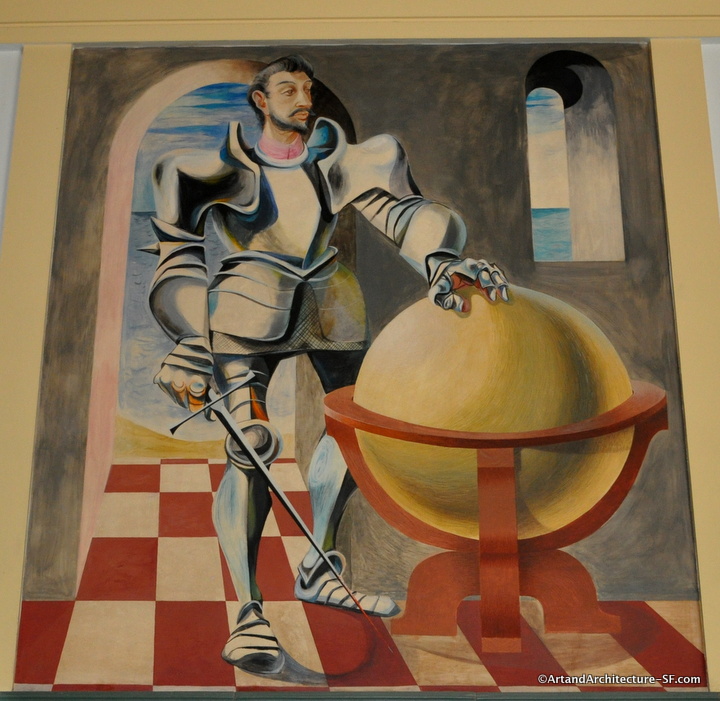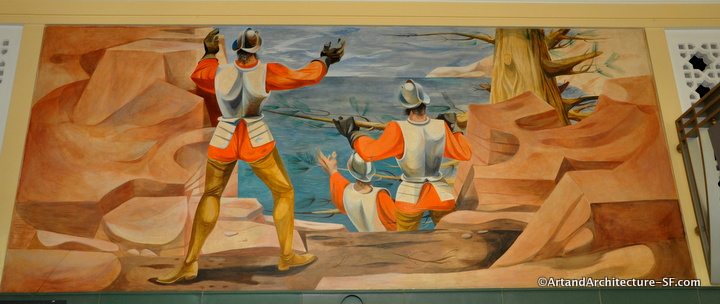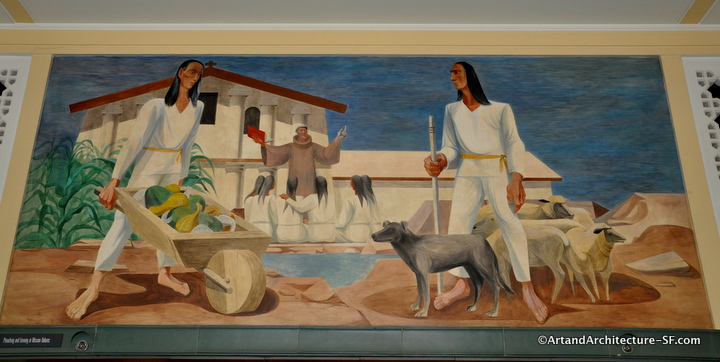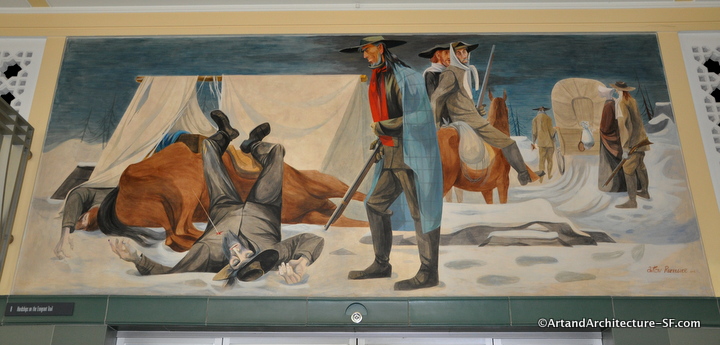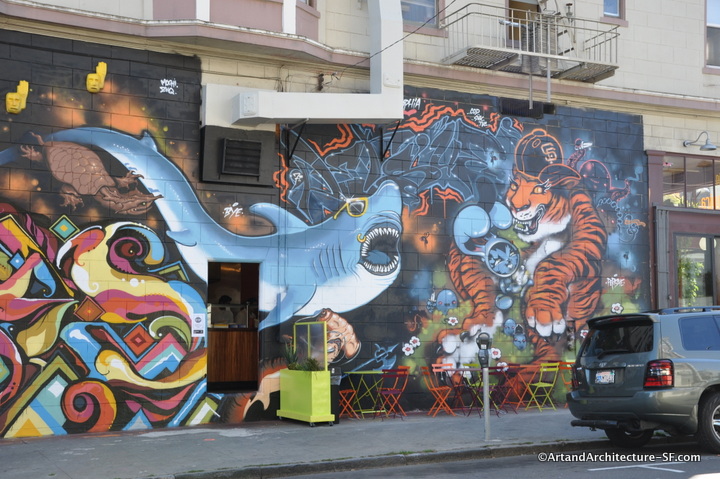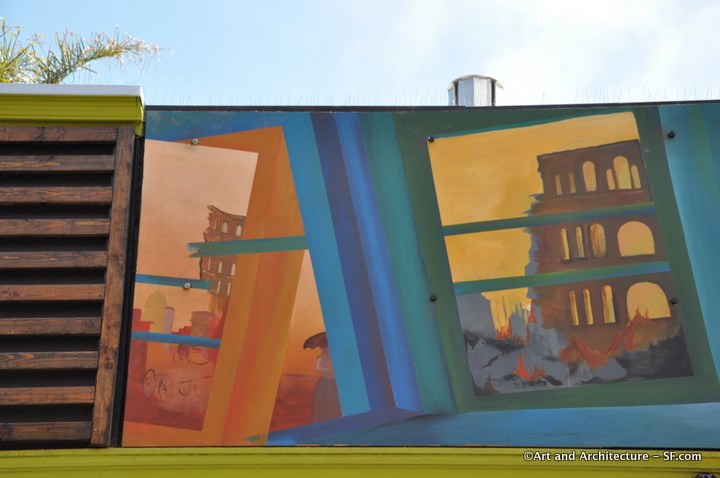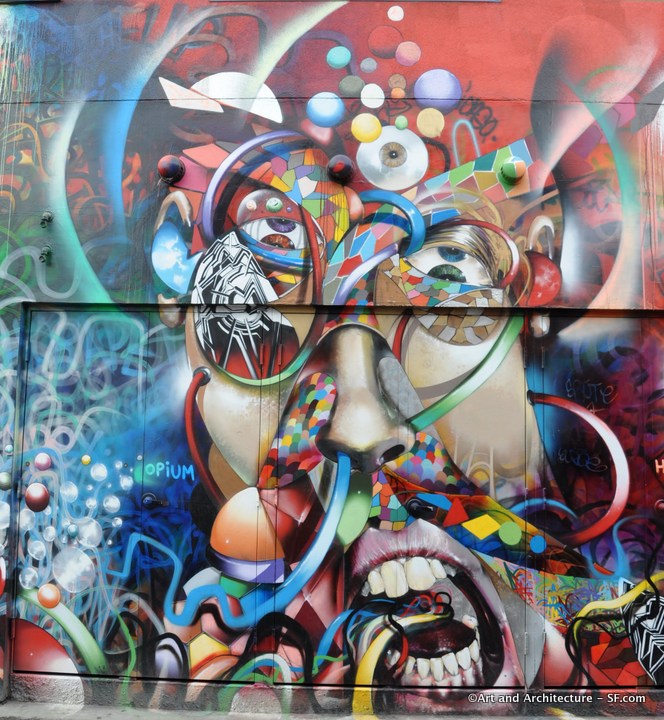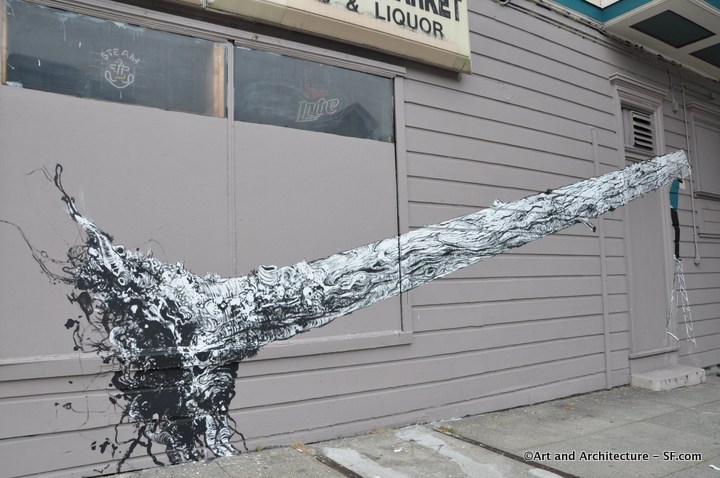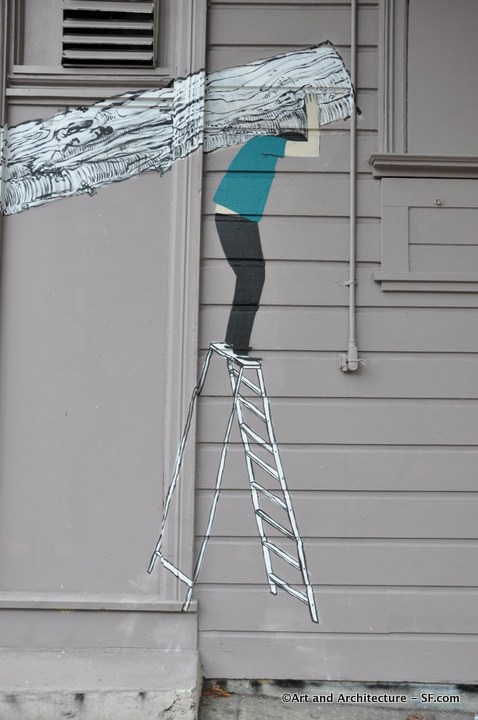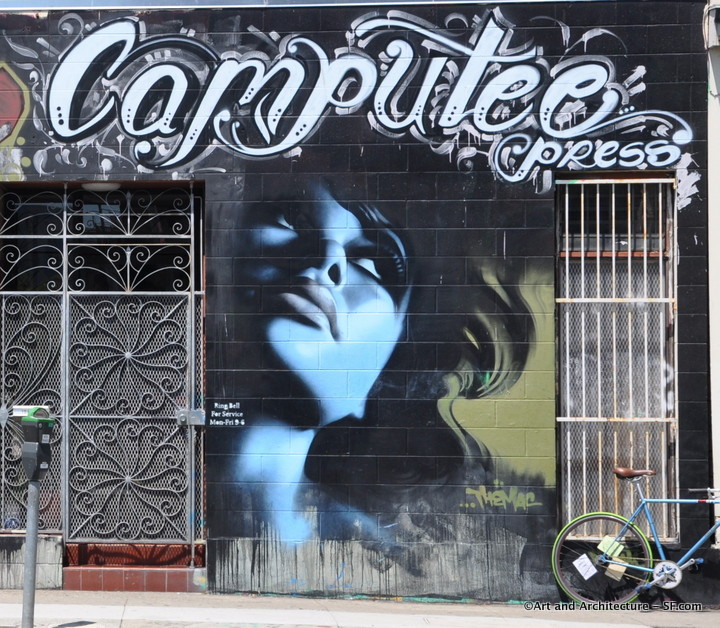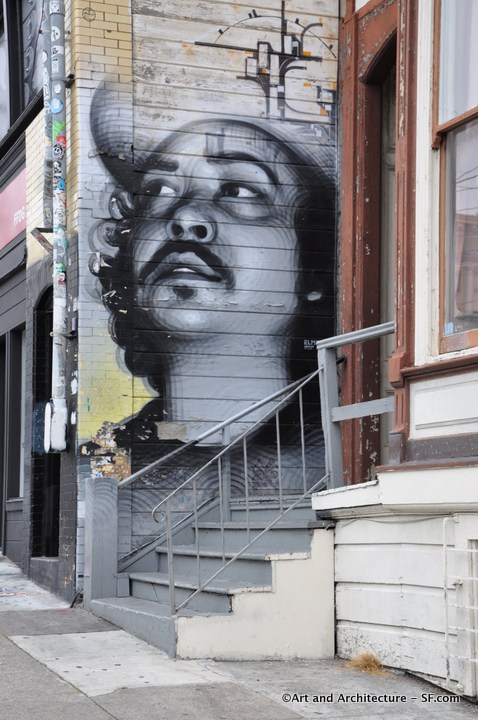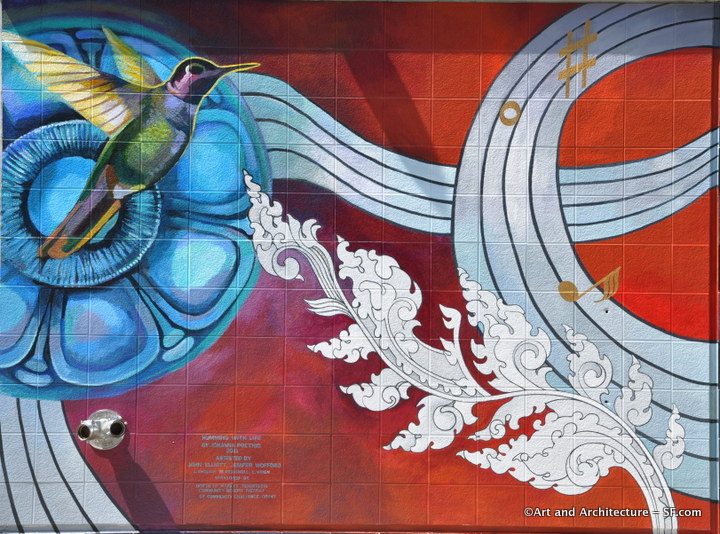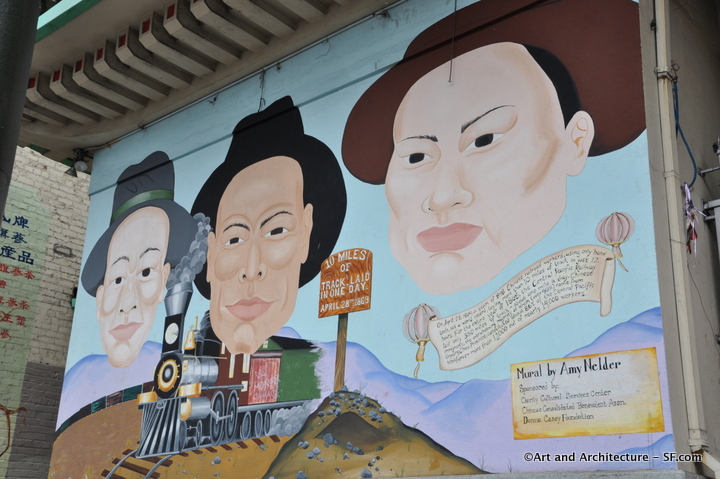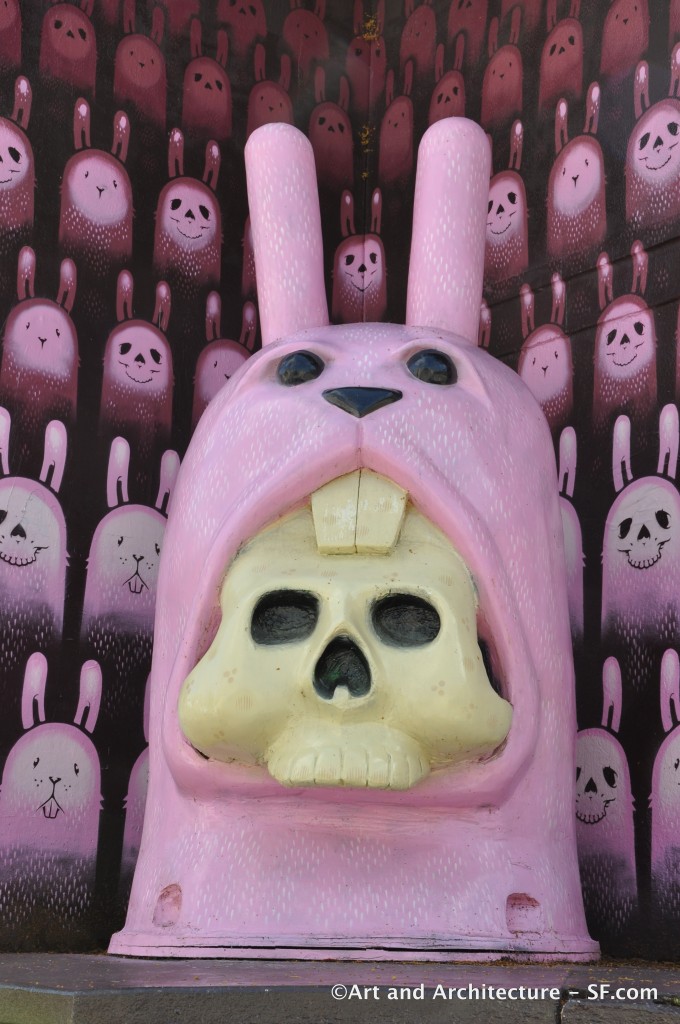This is the last in a series of the murals of Coit Tower. There are more, unfortunately, they are not available to the public. If you are interested in seeing pictures of them, and learning more about Coit Tower and all of the murals, I highly suggest you search out Masha Zakheim’s Book Coit Tower.
This is the second of the murals in the elevator alcove, It is titled San Francisco Bay, North and is by Jose Moya Del Pino (1869-1969). The two young men represent Moya del Pino himself watching as fellow artist Otis Oldfield sketches what he sees below him. If one looks closely you can see the former prison on the island of Alcatraz. This too is oil on canvas.
Jose Moya del Pino was born in Priego, Spain. By 1907, Moya was studied at the Academy of Fine Arts in Madrid, and associated with the Post-impressionists of Spain including Juan Gris and Diego Rivera. In the 1920’s he spent four years painting forty-one reproductions of Valasquez’s paintings in the El Prado in Madrid and Valencia. King Alfonso asked him to travel with the collection as a goodwill gesture when it went to the new world. The exhibit ended in San Francisco and Moya remained. Otis Oldfield was responsible for Moya being hired for the Coit Tower project. Later projects for Moya included a post office in Stockton as well as public art projects in Redwood City and San Rafael, California.
In the alcove, where visitors wait for the elevator are four more murals. This one is titled San Francisco Bay. This is an oil on canvas, and was painted in the artists studio. The two little girls are the artists, Otis Oldfield’s, daughters, Rhoda and Jayne. as they look down on the waterfront from their father’s Telegraph Hill studio. The larger island they are peering at is Yerba Buena Island. That is the island that the present day San Francisco Bay Bridge goes through. Treasure Island, which would have been attached on the left hand side of Yerba Buena, had not yet been built. Treasure Island was built (from fill dredged from the bay) for the Golden Gate International Exposition in 1939-1940.
Otis Oldfield was born in Sacramento in 1890. He came to San Francisco to enroll in Arthur Best’s private art school. In 1911, he went to Paris, where he stayed for sixteen years. In 1924, he began teaching at the California School of Fine Arts. He died in 1969.
The Coit Tower murals were painted during a particularly disruptive period in U.S. History. Depression related economic challenges led to much discussion about alternate forms of government. A four day general strike (Bloody Thursday) accompanied by widespread rioting in San Francisco triggered an eighty-three day 1934 West Coast Waterfront Strike.
Coit Tower muralists protested and picketed at the tower when Rivera’s mural commissioned for Rockefeller Center in New York City was destroyed after he refused to change an image of Lenin in the painting.
The opening of Coit Tower and the display of its murals was delayed several months because of the controversial content of some of the paintings. Clifford Wight’s mural, which contained a hammer and sickle as one of a series of medallions illustrating the range of political philosophies existing in America, was removed before the opening.
This particular mural depicts the anger that the artists felt at the destruction of Rivera/Rockefeller mural and the general tenet of the time.
Ralph Stockpole is reading a headline concerning the destruction of the Diego mural. Col. Harold Mack (on the Washington appointed supervisory committee for the murals) looks on while artist John Langley Howard holds a crumpled newspaper while reaching for Marx’s Das Kapital. Joseph Danysh (later federal Art Project director) holds a paper about mortgage foreclosures. Above the window are three Hebrew letters that spell out the contents of the three books lying on their sides: Torah, Prophets and Wisdom Literature.
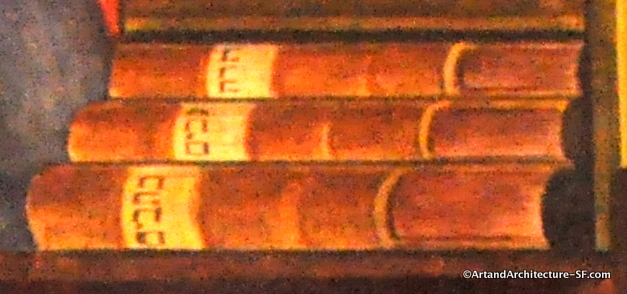 For those of you that are not familiar with the Rockefeller/Rivera controversy, here is a synopsis.
For those of you that are not familiar with the Rockefeller/Rivera controversy, here is a synopsis.
By 1930, Mexican muralist Diego Rivera has gained international favor for his lush and passionate murals. Inspired by Communist ideals and an intense devotion to his cultural heritage, Rivera creates boldly hued masterpieces of public art that adorn the municipal buildings of Mexico City. His outgoing personality puts him at the center of a circle of left-wing painters and poets, and his talent attracts wealthy patrons, including Abby Aldrich Rockefeller. In 1932, she convinces her husband, John D. Rockefeller, Jr., to commission a Rivera mural for the lobby of the soon-to-be-completed Rockefeller Center in New York City.
Flush from successes in San Francisco and Detroit, Rivera proposes a 63-foot-long portrait of workers facing symbolic crossroads of industry, science, socialism, and capitalism. The painter believes that his friendship with the Rockefeller family will allow him to insert an unapproved representation of Soviet leader Vladimir Lenin into a section portraying a May Day parade. The real decision-making power lies with the Center’s building managers, who abhor Rivera’s propagandistic approach. Horrified by newspaper articles attacking the mural’s anti-capitalist ideology, they order Rivera to remove the offending image. When Rivera refuses, offering to balance the work with a portrait of Abraham Lincoln on the opposing side, the managers pay his full fee, bar him from the site, and hide the mural behind a massive drape. Despite negotiations to transfer the work to the Museum of Modern Art and demonstrations by Rivera supporters, near midnight, on February 10th, 1934, Rockefeller Center workmen, carrying axes, demolish the mural. Later, Rivera recreates the frescoes in the Palace of Fine Arts in Mexico City, adding a portrait of John D. Rockefeller, Jr., in a nightclub. Rivera never works in the United States again, but continues to be active, both politically and artistically, until his death in 1957.
Mallete Dean was one of the more prolific painters of government sponsored murals in Northern California. Born in Washington in 1907, he studied at the California School of Fine Arts. He was a furniture designer, decorator of books and graphic artist, for many years he created labels for the California wine industry. Other works include the orchard scene in the Sebastapol, California Post Office. He died in San Francisco in 1975.
These two are Surveyor and Ironworker. There are three windows between these two figures. Over the central window Wight painted a bridge, which had the NRA Eagle in the center. Over the right hand window he stretched a segment of chain, and in the circle appeared the words In God We Trust, then over the last window he placed a section of woven cable and a circle framing a hammer and sickle, and the words United Workers of the World. This all proved to be entirely too controversial and it was removed before the tower opened in 1934.
Clifford Wight was born in England in 1900. He and Ralph Stackpole worked with Diego Rivera in the 1920’s. Wight came to San Francisco with Rivera to work as an assistant on Rivera’s murals at the San Francisco Art Institute. He also worked with Rivera on his Detroit mural. Diego Rivera painted a portrait of Wight into one of the frescos in the Secretariat of Education in Mexico City. He returned to England and died in 1966.
Fellow artist Fred Olmsted and his assistant Tom Hayes
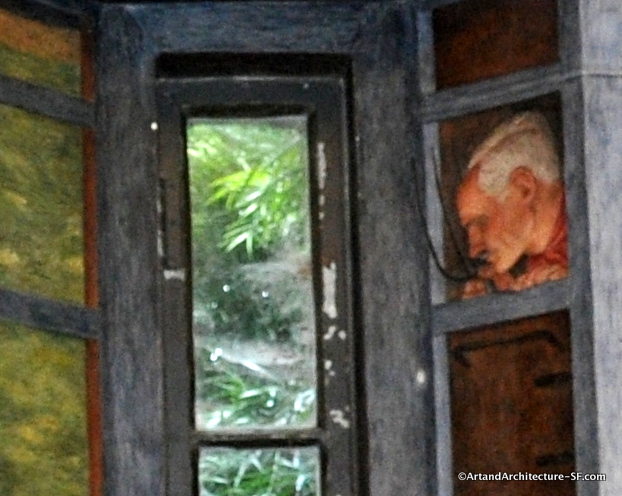 Fellow artist John Langley Howard holding a pitchfork
Fellow artist John Langley Howard holding a pitchfork
*
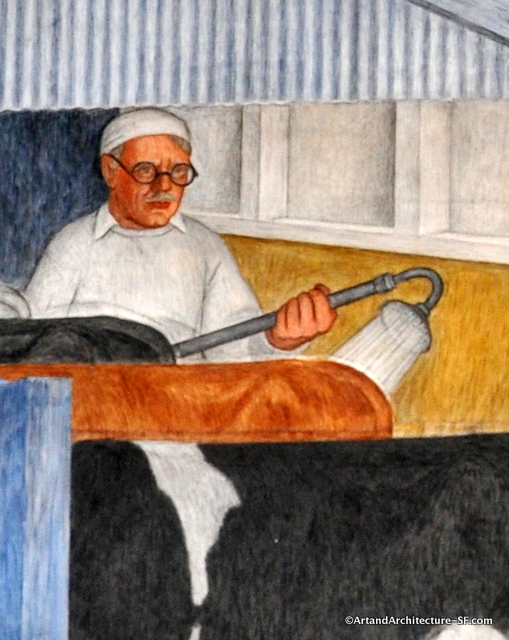 Fellow artist Lucien Labaudt showering a cow
Fellow artist Lucien Labaudt showering a cow
Englishman Ben Eine has many murals around San Francisco.
Here is a video of the installation:
The piece was done to launch his gallery exhibit at White Walls Gallery. They did a marvelous interview with him that you can read here.
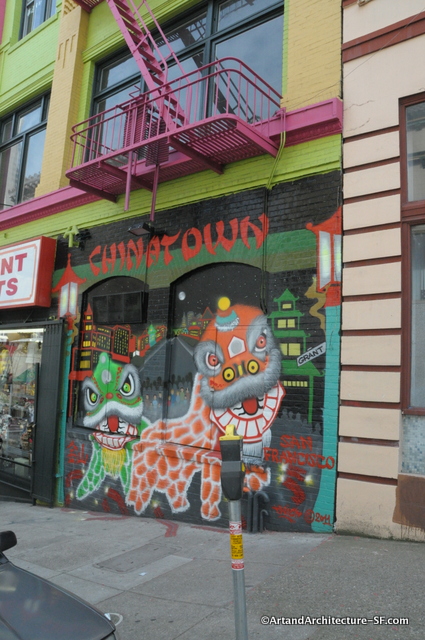 This mural is by Twick of ICP Crew who had a mural in SOMA that has since been painted over and another one around a Banksy in Chinatown.
This mural is by Twick of ICP Crew who had a mural in SOMA that has since been painted over and another one around a Banksy in Chinatown.
According to his Facebook page: “Twick” is a SF Hip Hop urban legend with many ranks like a general. He is one of the most respected figures shaping the Bay Area graffiti movement from the 80’s to present day. At the age of twelve Francisco (his real name) was inspired by the Chicano writing that decorated the walls of the Mission and his neighborhood. During this time he was introduced to his passion graffiti art. He is a self-taught artist who has been painting the art ever since it arrived in the Bay Area in the early 80’s. With 26 years of experience he uses Graffiti art as a positive tool. With his enduring passion evident through his everyday endeavors, Twick helps to break graffiti’s negative perception by transforming it to be looked upon as imaginative and inspirational works of contemporary art. He is a pioneer of hope and optimism painting murals with powerful images and full of culture. With the Mission and SOMA district walls as his canvas and his efforts to empower the local youth, Twick is dedicated to giving back to the community that raised him. In 2004 Precita Eyes gave him the opportunity to teach a graffiti mural class, Honored and inspired has been teaching youth workshops ever since.
According to the Listen to This Wall website – “Listen to This Wall is an initiative to bring a creative antidote to the ever increasing visual noise that crowds our urban landscape. Working with artists and designers to produce original works that offer new ways of seeing and being inspired in our city spaces.
The first of our walls is located in the historic district of Haight Ashbury in San Francisco and will feature a rotating selection of creative work.
Thank you to the building owner for donating this wall to the cause.”
This mural in the Haight Asbury district was dedicated to the rich history of the Haight Ashbury. It focuses on the elements born from the Summer of Love, and the movement sparked in 1967 towards a more peaceful society. It is located on the corner of Haight and Shrader, just half a block from the epicenter of the Summer of Love and where shows were played in the park.
The wall was rendered as 4 large psychedelic posters, the 3 to the right pay homage to the 3 big elements of the time: Peace, Poster Art, and Music. Each poster design gave nods at original 70’s posters, adorned with the lettering styles reminiscent of Victor Moscoso, Wes Wilson, Rick Griffin, Alton Kelley & Stanley Mouse. Just like back then, aesthetics were mixed, like photorealism, cartooning, illustration and a heaping spoonful of aerosol techniques.
The poster on the left are the signatures of the painters, integrated in a psychedelic poster art background. It is a way to tie the mural in with more personal roots of the artists, and showcase the legacy of illegible lettering styles.
The work was done by Lost, Satyr and Wes Wong of Fresh Paint. This crew is responsible a great dragon mural in Chinatown.
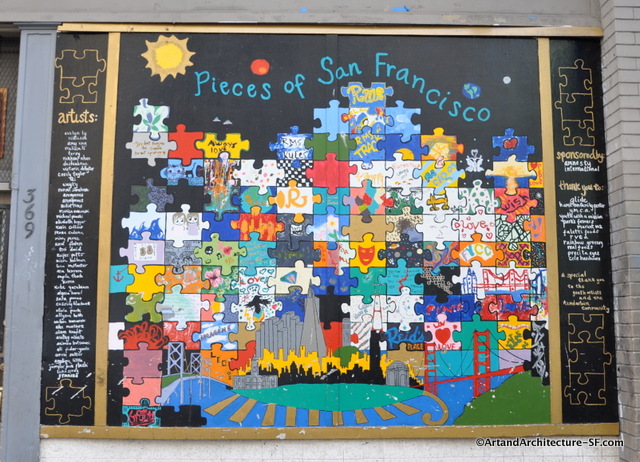 Pieces of San Francisco Mural Project – 2008 -Created by youth from Glide Memorial, Youth With a Mission, Golden Gate YMCA and Hamilton Family Center in collaboration with Amnesty International.
Pieces of San Francisco Mural Project – 2008 -Created by youth from Glide Memorial, Youth With a Mission, Golden Gate YMCA and Hamilton Family Center in collaboration with Amnesty International.
This mural is in the Tenderloin neighborhood of San Francisco, on the street side of the organization of “Youth with a Mission” on Ellis Street. This area in San Francisco is notorious for its problems with drugs sales and a as center for homelessness in the city. However the Tenderloin is also known for the intense community efforts to improve the area by providing opportunities for student outreach, care and education. The Amnesty International San Francisco office has coordinated this mural as a venue for students to empower themselves and beautify their own living space.
Approximately 40 youth were involved in the creation of the mural. Students from 1st grade thru high school and from various after school and summer programs came together to paint their own piece of the San Francisco Cityscape.
The mural is eight feet by six and a half feet. The San Francisco cityscape at the bottom of the mural is a silhouette below the sky. The sky has been tessellated with puzzle pieces. Each person taking part of the mural got their own puzzle “piece” to illustrate their part of San Francisco. To the right of the mural are names of all the artists involved.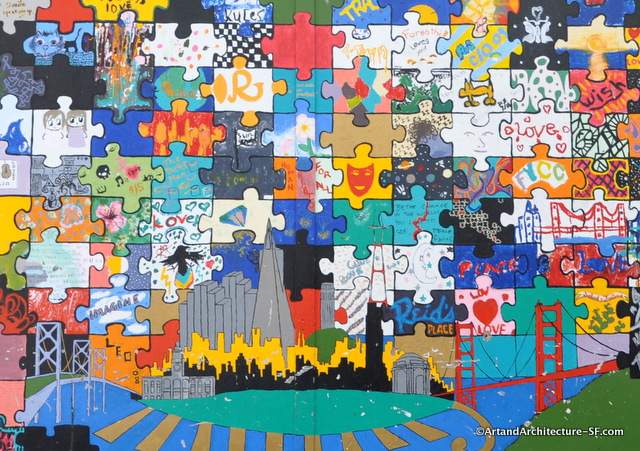
These are all by Mike Kershnar
The Citrus Report did a great interview with Mike, a fun excerpt: The greatest way graffiti has changed my life is the ever-present knowledge that whatever the visual landscape is, it has the potential to be artfully altered. Like if the intersection of Haight and Ashbury is important to me because of what it represented culturally, then I can make sure there is always a visual reminder of me around.
According to StudioVisit: Michael Kershnar is a 32-year old artist from California. His background in urban skateboarding and wilderness survival has given him a lifestyle that is in constant motion
The murals in the Rincon Annex Post Office, have lived a long and very controversial life. In 1941 the WPA held a competition for the murals, it was won by Anton Refregier. He began work immediately and kept at it until they were finished in 1948, with a two year break during the war. He was paid $26,000 for the job, the largest job ever given by the WPA in the painting/sculpture arena.
The twenty-seven murals (29 panels) are actually casein-tempra (a process of painting in which pigments are mixed with casein, or egg, especially egg yolk, to produce a dull finish) on white gesso over plaster walls.
The murals underwent 92 changes while they were being painted, all results of special interest groups. If you are interested in reading the controversy and politics involved in these changes, Rob Spoor has done an amazing job in his education of City Guides.
Panel #3. “Sir Francis Drake – 1579 Sir Francis Drake, an English navigator and privateer, set sail from Plymouth (England) in 1577 on a voyage around the world. According to accounts of that voyage, Drake landed in a California harbor in June of 1579. He stayed for 36 days during which time he had good relations with the Indians, repaired his ship and claimed the land for Queen Elizabeth of England, naming it Nova Albion. The precise location of Drake’s landing is not known. Various theories suggest it may have been Bolinas Bay, Drake’s Bay, the Marin side of San Francisco Bay. Bodega Bay or Point Reyes.” Notice the blood at the end of the sword, depicting the Spanish as a bloodthirsty lot.
Panel #4 “Conquistadors discover the Pacific Baja California was discovered by Europeans in 1533 by a man named Fortún Jiménez of the Cortés expedition. By 1540, Ulloa, another member of that expedition had explored the Sea of Cortés. Also in that year Hernando de Alarcón had sailed up the Colorado River and in 1541 Francisco de Bolaños explored both sides of the Baja Pennisula. The first European to explore Alta California, the land above the Baja Pennisula, was Juan Rodríguez Cabrillo who sailed to the Santa Barbara Islands in 1543.”
Panel #6. “Preaching and Farming at Mission Dolores The purpose of all California Missions was to Christianize the Indians. In addition to religion, the Indians learned farming, building, spinning and other basic skills. All instruction was given in Spanish.” According to Spoor the Catholic Church protested the large belly of a friar depicted in a Mission Dolores mural while the Indians appeared gaunt. In response to these objections, Refregier performed “artistic liposuction”.
Panel #24. Titled – “The Waterfront 1934. This controversial panel depicts events surrounding the San Francisco dock strike of 1934. On the left a shakedown operator demands bribes in exchange for longshoremen jobs. The center shows labor organizer Harry Bridges addressing dockworkers. The right third refers to what is known as “Bloody Thursday, July 5, 1934, when employers battle strikers to open the docks. Two longshoremen died and many on both sides were injured.”
Again, according to Spoor, The VFW and even some labor organizations were incensed that labor organizer and alleged Communist Harry Bridges appeared to be rallying workers, including one with a VFW insignia on his hat, in the mural “Maritime and General Strike,” and pointed out several inaccuracies in the three historical events depicted. The longshore workers union was especially sensitive to the association with 1930s-era Communism, from which they’d distanced themselves by the late 1940s. In response to their objections, Refregier painted out the VFW symbol.
From: Anton Refregier: Renaissance Man of WPA
Of the 27 panels covering the walls of Rincon, the most widely reproduced (via silkscreen) is the scene “San Francisco ’34 Waterfront Strike,” which takes on the 82-day strike that crippled the shipping industry all along the West Coast. Workers were striking against low wages caused by corruption and graft, and before the outrage and rioting died down, three men were killed, out of the 31 who were shot by police and the dozens who were beaten and assaulted with gas. Refregier did not paint violence or defeat in his mural, but instead focused on the solidarity of the union workers.
All these descriptions can be found on plaques near the murals.
 Mid market is a desolate stretch of abandoned store fronts and SRO’s. This long frontage of boarded up building has been covered by an artist known as Chor. This is not any random street painter, Chor has a worldwide body of work, including a commissioned piece for the Beijing Olympics. His website
Mid market is a desolate stretch of abandoned store fronts and SRO’s. This long frontage of boarded up building has been covered by an artist known as Chor. This is not any random street painter, Chor has a worldwide body of work, including a commissioned piece for the Beijing Olympics. His website
displays his incredible talent, and his blog is loaded with fabulous images of his work.
I had the privilege of seeing some of his art gallery work at “The City We Love” showing at 941 Geary street. If you are in the neighborhood, drop in and ask about him. The piece below is on Clarion Alley in the Mission District. Chor has also done it on a smaller scale, and it is on display at 941 Geary.
The Haight – San Francisco
Miles “Mac” McGregor. Goes by The Mac or El Mac. According to his own website El Mac was “born in Los Angeles in 1980 to an engineer and an artist, Mac has been creating and studying art independently since childhood. His primary focus has been the lifelike rendering of human faces and figures. He has drawn inspiration from the surrounding Mexican & Chicano culture of Phoenix and the American Southwest, religious art, pin-up art, graffiti, and a wide range of classic artists such as Caravaggio, Mucha, and Vermeer. He began painting with acrylics and painting graffiti in the mid ’90s, and has since worked consistently towards mastering his signature portrait style. Around 1998 he began to paint technicolor aerosol versions of classic paintings by old European masters. This led to being commissioned in 2003 by the Groeninge Museum in Brugge, Belgium to paint his interpretations of classic Flemish Primitive paintings in the museum’s collection. He has since been commissioned to paint murals across the US, as well as in Mexico, Denmark, Sweden, Canada, South Korea, Belgium, Italy, The Netherlands, Puerto Rico, Spain, France, Singapore, Germany, Ireland, and Vietnam.”
While I am grateful for the murals that he has done in San Francisco, please go to his website and check out some of the amazing work he has done around the world. If you go to the spraypaint section and get as far as page 9, you will find, what I hesitate to label as my favorite, but certainly worth seeking out – Young Scribe.
This is directly from her blog – “Humming With Life”, the title of this mural is an understatement. The Post Office building at the corner of Hyde and Golden Gate is a magnet for drug dealers, crack addicts and homeless folks looking for a spot to lie down. The Tenderloin has long been the neighborhood that offers services to the down and out so this is where they live with the vibrant mix of cultures and community in the North of Market of downtown San Francisco. The Civic Center Post Office does not sell stamps or send mail. It has endless rows of post office boxes for people without permanent addresses.”
She has truly added a bright spot in a rather sorry part of town.
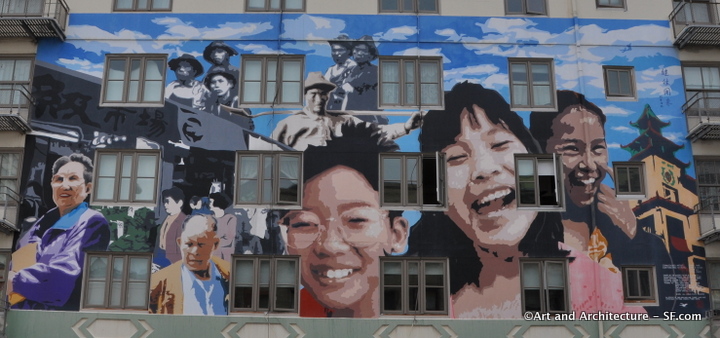 This mural is also on the Ping Yuen Housing Project. This is the Stockton Street Side of the building.
This mural is also on the Ping Yuen Housing Project. This is the Stockton Street Side of the building.
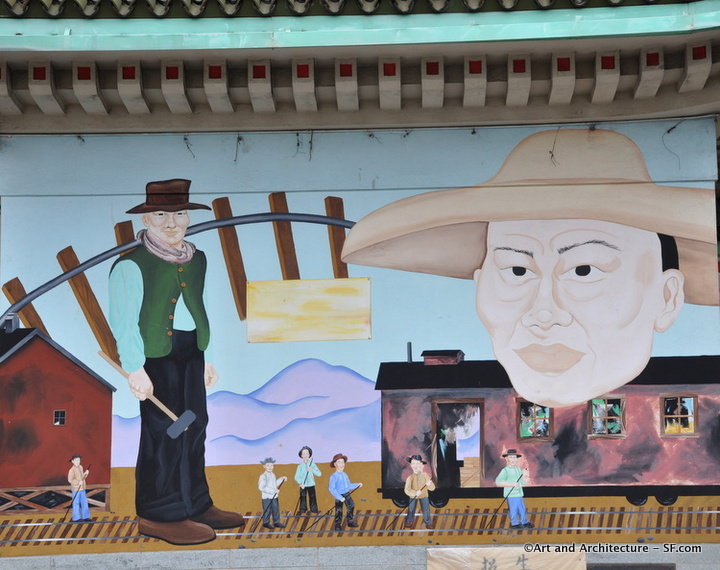 Walking further down Stockton Street towards the tunnel you will find this mural on the Victory Memorial Hall it was erected by the China War Relief Association of America and painted by Amy Nelder.
Walking further down Stockton Street towards the tunnel you will find this mural on the Victory Memorial Hall it was erected by the China War Relief Association of America and painted by Amy Nelder.According to Wendy’s website she “comes from a rich San Francisco tradition. Her grandfather, Al Nelder, was the revered former Chief of Police for San Francisco and her mother, Wendy, is the former president of the San Francisco Board of Supervisors. She continues that spirit of public service by being one of only 18 fulltime forensic artists in the United States as the forensic artist for the San Francisco Police Department.”
 This mural is on the corner of 10th Street and Sheridan in the South of Market Area of San Francisco. The artist is Meagan Spendlove. Her website reads “Meagan Spendlove currently works in San Francisco, California as a professional designer, illustrator and project coordinator. Her latest endeavors include yet are not limited to mural project coordination and digital illustration. Over the past twelve years her style has become recognized mainly for its feminine subject matter and organic ingredients. Assorted shaded ethereal women & bright colors surrounded by bold lines, similar to stained glass.”
This mural is on the corner of 10th Street and Sheridan in the South of Market Area of San Francisco. The artist is Meagan Spendlove. Her website reads “Meagan Spendlove currently works in San Francisco, California as a professional designer, illustrator and project coordinator. Her latest endeavors include yet are not limited to mural project coordination and digital illustration. Over the past twelve years her style has become recognized mainly for its feminine subject matter and organic ingredients. Assorted shaded ethereal women & bright colors surrounded by bold lines, similar to stained glass.”
The bright colors are what caught my eye, otherwise, it is on a very obscure alley and very easy to miss.
